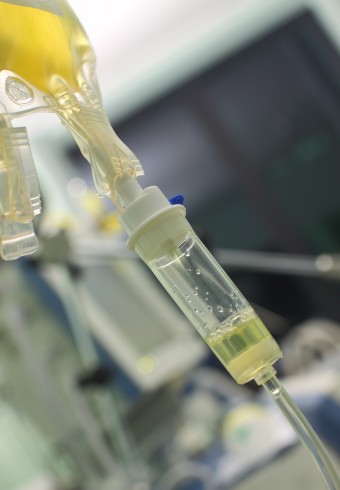The Man Who Saved Over Two Million Lives via a Genetic Quirk
 Today I found out about a man who saved over two million lives just by donating his somewhat unique blood plasma.
Today I found out about a man who saved over two million lives just by donating his somewhat unique blood plasma.
Australian James Harrison is called “the man with the golden arm” due to the unusual composition of his blood. Harrison’s blood contains an antibody called Rho(D) Immune Globulin that is used to treat Rhesus disease, a severe form of anemia where antibodies in a pregnant woman’s blood destroy her baby’s blood cells.
James Harrison may never have discovered this quirk in his bloody if it were not for the fact that when he was 13 in 1949, Harrison had major chest surgery. The surgery required transfusions of almost three-and-a-half gallons of blood. During the three months he spent recovering in the hospital, grateful for the donated blood that had saved his life, he pledged to start donating his own as soon as he was legally old enough as a way to pay back the kindness of the strangers who donated the blood he used. (At the time, one needed to be 18 to donate blood.)
In 1954, when Harrison turned 18 and started giving blood, it was quickly discovered that his blood contained a rare, very valuable lifesaving antibody that could be used to treat Rhesus disease.
At that time, Rhesus disease was killing tens of thousands of babies per year (around 10,000 annually in the U.S. alone), as well as causing major birth defects such as brain damage. Most people (about 85%) have a special protein in their blood cells called the Rh factor, which makes them Rh positive (positive blood type); the remainder, who lack Rh factor, are called Rh negative (and have a negative blood type).
Women who’ve been pregnant may remember the Rh blood test, which screens to detect any incompatibility: “If [mother] is Rh-negative and . . . baby is Rh-positive, [mother’s] body will react to the baby’s blood as a foreign substance. [Mother’s] body will create antibodies (proteins) against the baby’s Rh-positive blood . . . . Rh incompatibility is more likely to cause problems in second or later pregnancies [when] Rh antibodies can cross the placenta and attack the baby’s red blood cells . . . lead[ing] to hemolytic anemia in the baby.”
Luckily, if an incompatibility is found early on, there is a prenatal treatment (Rh immune globulin) that will prevent any problems before they start. This works by introducing antibodies that will attach to Rh-positive red blood cells. This effectively makes it so the mother’s immune system won’t detect and then try to destroy them.
When the discovery was made about Harrison’s blood, he agreed to undergo extensive tests and experiments that eventually led to the development of a vaccine called Anti-D. Harrison said he was eager to help but some precautions were taken in case something happened to him during the testing. “They insured me for a million dollars so I knew my wife Barbara would be taken care of. I wasn’t scared. I was glad to help,” Harrison said in a 2010 interview.
Besides letting himself be used as a guinea-pig in the development of the Anti-D vaccine, Harrison has donated an extreme amount of plasma. Plasma can be given every two to three weeks, unlike whole blood, which is only recommended to be donated every six weeks. This allowed Harrison to donate over 1000 times in the 57 years he’s been doing it. He has continued to donate since he reached 1000 donations in 2011. It is estimated Harrison has helped save about 2-2.5 million people so far. Among that number, his own daughter, Tracey, had to have the Anti-D injection after the birth of her son.
If you liked this article, you might also enjoy our new popular podcast, The BrainFood Show (iTunes, Spotify, Google Play Music, Feed), as well as:
- What are the Best Ways to Lower Blood Pressure Naturally?
- What Do the Numbers in a Blood Pressure Test Mean and What Does This Test Tell the Doctor?
- Fact or Myth: Sodium Raises Blood Pressure
- How Blood Works and the Difference Between Blood Types
- In a Transplant/Transfusion, Does the Donor’s DNA Get Integrated Into the New Host?
Bonus Facts:
- The Rhesus factor was discovered by Philip Levine and Rufus E. Stetson in 1939 after they studied a woman who’d had a baby and then subsequently gotten pregnant again, this time with the baby being stillborn. Due to blood loss while giving birth, she was given type-O blood (donated from her husband) which matched her apparent blood type. Despite this, her body reacted to the blood as if she had been given the wrong blood type. Levine and Stetson theorized then that there must be some undiscovered blood group antigen at play here. They also theorized that the mother’s immune system must have been sensitized by the fetus’ red blood cells, with the baby carrying the father’s blood type.
- Rhesus disease typically becomes worse with each successive pregnancy and it is rare for the first Rhesus positive baby to be affected by the disease. The first pregnancy is significant because a Rhesus negative mother can be sensitized to the Rh positive antigen.
- The incidence of Rhesus disease is very low in non-Caucasian populations, but among Caucasians, about one in ten pregnancies are to a Rhesus negative woman with a Rhesus positive baby with approximately 13% of Rhesus negative mothers sensitized by their first pregnancy.
| Share the Knowledge! |
|





10 comments